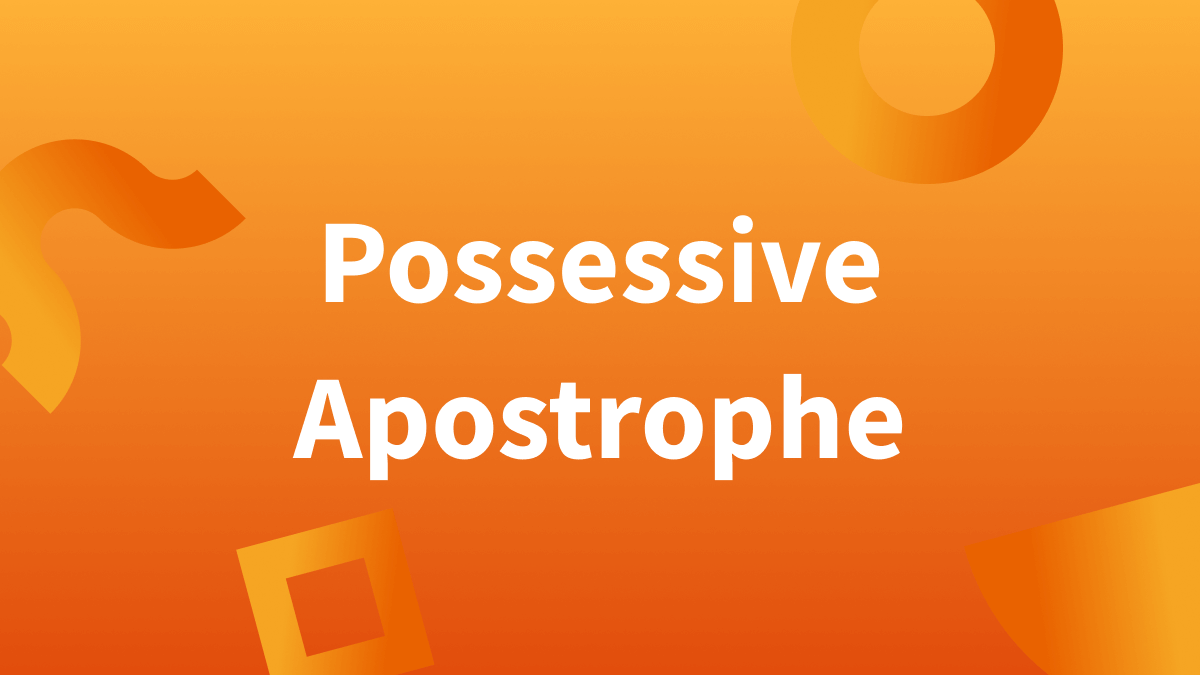Possessive Apostrophe: Quick Summary
A possessive apostrophe indicates possession.
- Tom’s car is in the shop.
In the sentence above, the car belongs to Tom.
There are several ambiguous rules about how to use the possessive apostrophe, especially when it comes after an “S”. For example, if a singular noun ends with an “S,” either option is acceptable:
- Chris’s baby is getting baptized today.
- Chris’ baby is getting baptized today.
There are many other rules you should be aware of to use the possessive apostrophe correctly.
Learn How To Use the Possessive Apostrophe With:
You’re here because you’re not entirely sure how to use the possessive apostrophe, especially when the word ends with an “S.” It may bring you some relief to know that the rules surrounding possessive apostrophes after S” can be a bit hazy.
Nevertheless, we’re going to thoroughly review these guidelines and provide easy-to-understand examples to help you better understand these tricky apostrophes.
Let’s get started!

Possessive Apostrophe: Rules and Examples
It’s worth reiterating that the guidelines below are not always clear-cut. Sometimes, different experts and guidelines recommend different usage when it comes to the possessive apostrophe after an “S.”
Possessive Apostrophes and Singular Nouns
Forming possessive singular nouns to words that don’t end in “S” is pretty straightforward: All you have to do is add an apostrophe + “S”. This is true of both common and proper nouns.
The bird’s feathers are colorful.
Juliet’s bag is missing.
If the singular noun ends in “S”, it is usually recommended to add an apostrophe + “S,” whether it’s a common or proper noun.
The octopus’s ability to camouflage was impressive.
Charles’s flight got delayed.
However, it’s also acceptable to just add an apostrophe to singular nouns that end in “S.” (See what we mean by the rules being ambiguous?)
The octopus’ ability to camouflage was impressive.
Charles’ flight got delayed.
Possessive Apostrophes and Plural Nouns
Typically, if a plural noun ends with an “S,” you simply have to add an apostrophe.
My twin brothers’ birthday party is tomorrow.
But what about plural nouns that don’t end in “S”? In that case, you would add an apostrophe + “S”.
The children’s toys were designed to help them learn the alphabet.
Knowing this, the placement of the apostrophe can inform you whether the noun is singular possessive or plural possessive. For example,
The tiger’s enclosure was filled with snacks and goodies.
Because tiger is followed by an apostrophe + “S,” you can deduce that one tiger had its cage filled with snacks and goodies. On the contrary,
The tigers’ enclosure was filled with snacks and goodies.
In the example above, the enclosure belongs to multiple tigers, and it was filled with snacks and goodies.
Possessive Apostrophes and Plural Last Names
Usually, last names become plural by simply adding an “S.”
The Smith family → The Smiths
However, if the last name ends with an “S” or “Z,” then it is pluralized by adding
“–es.”
The Jones family → The Joneses
The Lopez family → The Lopezes
That being said, you should pluralize the last name and then add the apostrophe as needed.
Sadly, the Smiths’ home was destroyed during the hurricane.
But the Joneses’ generosity helped them recover quickly.
Possessive Apostrophes and Classical/Biblical Names
The guidelines can be a little different for classical and biblical names. Usually, names that end in “S” or “ES” and have two syllables or more, simply get an apostrophe.
I enjoy going to church to learn about Jesus’ teachings.
Socrates’ philosophies are still widely popular.
However, if the name is only one syllable, then it typically gets an apostrophe + “S” added to it.
Zeus’s lightning bolt is a symbol of power.
Possessive Apostrophes and Possessive Pronouns
Possessive pronouns (e.g., ours, yours, his, hers, theirs, etc.) take no apostrophe.
That laptop is ours.
The umbrella is hers.
Is that bird yours?
Possessive Apostrophes and Indefinite Pronouns
Indefinite pronouns (e.g., anyone, everyone, somebody, etc.) use the singular possessive form.
That could be anyone’s briefcase.
That is definitely somebody’s pet because it looks healthy and well-fed.
Possessive Apostrophes and Compound Nouns
For compound nouns that contain separate words (e.g., Christmas tree or Alex and John), you only need to add an apostrophe + “S” to the last noun.
The Christmas tree’s lights were very bright and festive.
Alex and John’s new apartment is really spacious.
Possessive Apostrophes for Buildings, Objects, and Pieces of Furniture
If you are indicating possession for a building, object, or piece of furniture, there is no need to use an apostrophe.
The office bathroom is out of order.
The office’s bathroom is out of order.
The laptop screen was damaged.
The laptop’s screen was damaged.
The chair leg was wobbly.
The chair’s leg was wobbly.
Using Possessive Apostrophes Correctly
Don’t get overwhelmed by the vast number of rules there are for possessive apostrophes. If you’re writing for a publication, make sure to follow their style guide. If you’re writing for school, ask your teacher which rules you should stick to. What’s important is that you remain consistent throughout your writing. Don’t follow one rule in one paragraph, and then another in the next.
As an advanced, multilingual writing assistant, LanguageTool can ensure the correct use of possessive apostrophes (and other types of punctuation). It also scans your text for grammar and spelling errors and stylistic imperfections to help you write flawlessly.
LanguageTool’s proofreading abilities will leave you impressed! Try it out today.

